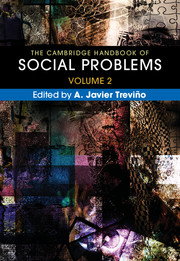Book contents
- The Cambridge Handbook of Social Problems
- The Cambridge Handbook of Social Problems
- Copyright page
- Contents
- About the Contributors
- Introduction
- Part I Problems Related to Health, Safety, and Security
- Part II Problems Related to Crime and Violence
- Part III Problems of Global Impact
- Chapter 27 Urbanism and Urbanization
- Chapter 28 Technology and Social Problems
- Chapter 29 Population and Contemporary Social Problems
- Chapter 30 Environmental Problems
- Index
- References
Chapter 27 - Urbanism and Urbanization
from Part III - Problems of Global Impact
Published online by Cambridge University Press: 16 March 2018
- The Cambridge Handbook of Social Problems
- The Cambridge Handbook of Social Problems
- Copyright page
- Contents
- About the Contributors
- Introduction
- Part I Problems Related to Health, Safety, and Security
- Part II Problems Related to Crime and Violence
- Part III Problems of Global Impact
- Chapter 27 Urbanism and Urbanization
- Chapter 28 Technology and Social Problems
- Chapter 29 Population and Contemporary Social Problems
- Chapter 30 Environmental Problems
- Index
- References
Summary
The social problems that arise specifically from the way people live in cities (i.e., urbanism) and the ways that cities grow (i.e., urbanization) echo many of the same issues that concern scholars of social problems in general. What makes “the city” unique, however, is that it plays host to many social problems that overlap, that merge, and that are connected within and between specific geographical places. The shift from rural, traditional human settlements to increasingly urban, industrial ones generated a great deal of fear and anxiety in both early urban studies scholars and early urban inhabitants. Here, we focus on a few of the main contemporary urban social problems related to race relations and other inequalities. Of particular interest to students and scholars investigating today's cities in the United States and around the world are the changing built environments and their urban populations. As such, we explore the role of gentrification and its effects on neighborhood demographics and the consistently shifting urbanism.
- Type
- Chapter
- Information
- The Cambridge Handbook of Social Problems , pp. 475 - 488Publisher: Cambridge University PressPrint publication year: 2018
References
- 2
- Cited by



